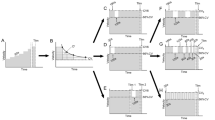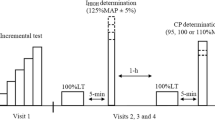Abstract
This study aimed to use the intermittent critical velocity (ICV) model to individualize intermittent exercise and analyze whether a fast-start strategy could increase the time spent at or above 95 %VO2max (t95VO2max) during intermittent exercise. After an incremental test, seven active male subjects performed three intermittent exercise tests until exhaustion at 100, 110, and 120 % of the maximal aerobic velocity to determine ICV. On three occasions, the subjects performed an intermittent exercise test until exhaustion at 105 % (IE105) and 125 % (IE125) of ICV, and at a speed that was initially set at 125 %ICV but which then decreased to 105 %ICV (IE125–105). The intermittent exercise consisted of repeated 30-s runs alternated with 15-s passive rest intervals. There was no difference between the predicted and actual Tlim for IE125 (300 ± 72 s and 284 ± 76 s) and IE105 (1,438 ± 423 s and 1,439 ± 518 s), but for IE125–105 the predicted Tlim underestimated the actual Tlim (888 ± 211 s and 1,051 ± 153 s, respectively). The t95VO2max during IE125–105 (289 ± 150 s) was significantly higher than IE125 (113 ± 40 s) and IE105 (106 ± 71 s), but no significant differences were found between IE125 and IE105. It can be concluded that predicting Tlim from the ICV model was affected by the fast-start protocol during intermittent exercise. Furthermore, fast-start protocol was able to increase the time spent at or above 95 %VO2max during intermittent exercise above ICV despite a longer total exercise time at IE105.




Similar content being viewed by others
Abbreviations
- CP:
-
Critical power
- CV:
-
Critical velocity
- Dlim:
-
Total distance covered
- HRmax:
-
Maximal heart rate
- IE105 :
-
Intermittent exercise at 105 %ICV
- IE125 :
-
Intermittent exercise at 105 %ICV
- IE125–105 :
-
Intermittent exercise that began at 125 %ICV and decreased to 105 %ICV
- ICV:
-
Intermittent critical velocity
- [La]max :
-
Maximal blood lactate concentration
- MAV:
-
Maximal aerobic velocity
- t95VO2max :
-
Time spent at or above 95 %VO2max
- Tlim:
-
Time to exhaustion
- TotO2 :
-
Total amount of oxygen consumed
- VO2 :
-
Oxygen uptake
- VO2max :
-
Maximal oxygen uptake
- VO2peak :
-
Peak oxygen uptake
- W′:
-
Finite energy reserve
References
Bailey SJ, Vanhatalo A, DiMenna FJ, Wilkerson DP, Jones AM (2011) Fast-start strategy improves VO2 kinetics and high-intensity exercise performance. Med Sci Sports Exerc 43(3):457–467
Bearden SE, Moffatt RJ (2001) VO2 and heart rate kinetics in cycling: transitions from an elevated baseline. J Appl Physiol 90(6):2081–2087
Berthoin S, Baquet G, Dupont G, Van Praagh E (2006) Critical velocity during continuous and intermittent exercises in children. Eur J Appl Physiol 98(2):132–138
Billat VL, Blondel N, Berthoin S (1999) Determination of the velocity associated with the longest time to exhaustion at maximal oxygen uptake. Eur J Appl Physiol Occup Physiol 80(2):159–161
Billat VL, Morton RH, Blondel N, Berthoin S, Bocquet V, Koralsztein JP, Barstow TJ (2000a) Oxygen kinetics and modelling of time to exhaustion whilst running at various velocities at maximal oxygen uptake. Eur J Appl Physiol 82(3):178–187
Billat VL, Slawinski J, Bocquet V, Demarle A, Lafitte L, Chassaing P, Koralsztein JP (2000b) Intermittent runs at the velocity associated with maximal oxygen uptake enables subjects to remain at maximal oxygen uptake for a longer time than intense but submaximal runs. Eur J Appl Physiol 81(3):188–196
Billat VL, Slawinksi J, Bocquet V, Chassaing P, Demarle A, Koralsztein JP (2001) Very short (15 s–15 s) interval-training around the critical velocity allows middle-aged runners to maintain VO2max for 14 minutes. Int J Sports Med 22(3):201–208
Brandon LJ (1995) Physiological factors associated with middle distance running performance. Sports Med 19(4):268–277
Buchheit M, Laursen PB, Millet GP, Pactat F, Ahmaidi S (2008) Predicting intermittent running performance: critical velocity versus endurance index. Int J Sports Med 29(4):307–315
Burnley M, Davison G, Baker JR (2011) Effects of priming exercise on VO2 kinetics and the power-duration relationship. Med Sci Sports Exerc 43(11):2171–2179
Caputo F, Denadai BS (2004) Effects of aerobic endurance training status and specificity on oxygen uptake kinetics during maximal exercise. Eur J Appl Physiol 93(1–2):87–95
Chidnok W, Dimenna FJ, Bailey SJ, Vanhatalo A, Morton RH, Wilkerson DP, Jones AM (2012) Exercise tolerance in intermittent cycling: application of the critical power concept. Med Sci Sports Exerc 44(5):966–976
Creer AR, Ricard MD, Conlee RK, Hoyt GL, Parcell AC (2004) Neural, metabolic, and performance adaptations to four weeks of high intensity sprint-interval training in trained cyclists. Int J Sports Med 25(2):92–98
Demarie S, Koralsztein JP, Billat V (2000) Time limit and time at VO2max during a continuous and an intermittent run. J Sports Med Phys Fitness 40(2):96–102
Denadai BS, Ortiz MJ, Greco CC, de Mello MT (2006) Interval training at 95 % and 100 % of the velocity at VO2max: effects on aerobic physiological indexes and running performance. Appl Physiol Nutr Metab 31(6):737–743
DiMenna FJ, Wilkerson DP, Burnley M, Jones AM (2008) Influence of priming exercise on pulmonary O2 uptake kinetics during transitions to high-intensity exercise from an elevated baseline. J Appl Physiol 105(2):538–546
Dupont G, Blondel N, Lensel G, Berthoin S (2002) Critical velocity and time spent at a high level of VO2 for short intermittent runs at supramaximal velocities. Can J Appl Physiol 27(2):103–115
Fukuba Y, Miura A, Endo M, Kan A, Yanagawa K, Whipp BJ (2003) The curvature constant parameter of the power-duration curve for varied-power exercise. Med Sci Sports Exerc 35(8):1413–1418
Fukuda DH, Smith AE, Kendall KL, Cramer JT, Stout JR (2011) The determination of critical rest interval from the intermittent critical velocity test in club-level collegiate hockey and rugby players. J Strength Cond Res 25(4):889–895
Fukuda DH, Smith AE, Kendall KL, Hetrick RP, Hames RL, Cramer JT, Stout JR (2012) The reliability of the intermittent critical velocity test and assessment of critical rest interval in men and women. Eur J Appl Physiol 112(4):1197–1205
Gaesser GA (1994) Influence of endurance training and catecholamines on exercise VO2 response. Med Sci Sports Exerc 26(11):1341–1346
Gastin PB (2001) Energy system interaction and relative contribution during maximal exercise. Sports Med 31(10):725–741
Gerbino A, Ward SA, Whipp BJ (1996) Effects of prior exercise on pulmonary gas-exchange kinetics during high-intensity exercise in humans. J Appl Physiol 80(1):99–107
Hill DW (1993) The critical power concept. A review. Sports Med 16(4):237–254
Hill DW, Ferguson CS (1999) A physiological description of critical velocity. Eur J Appl Physiol Occup Physiol 79(3):290–293
Housh DJ, Housh TJ, Bauge SM (1989) The accuracy of the critical power test for predicting time to exhaustion during cycle ergometry. Ergonomics 32(8):997–1004
Jones AM, Wilkerson DP, Vanhatalo A, Burnley M (2008) Influence of pacing strategy on O2 uptake and exercise tolerance. Scand J Med Sci Sports 18(5):615–626
Jones AM, Vanhatalo A, Burnley M, Morton RH, Poole DC (2010) Critical power: implications for determination of VO2max and exercise tolerance. Med Sci Sports Exerc 42(10):1876–1890
Midgley AW, Mc Naughton LR (2006) Time at or near VO2max during continuous and intermittent running. A review with special reference to considerations for the optimisation of training protocols to elicit the longest time at or near VO2max. J Sports Med Phys Fitness 46(1):1–14
Midgley AW, McNaughton LR, Wilkinson M (2006) Is there an optimal training intensity for enhancing the maximal oxygen uptake of distance runners? Empirical research findings, current opinions, physiological rationale and practical recommendations. Sports Med 36(2):117–132
Midgley AW, McNaughton LR, Carroll S (2007a) Time at VO2max during intermittent treadmill running: test protocol dependent or methodological artefact? Int J Sports Med 28(11):934–939
Midgley AW, McNaughton LR, Jones AM (2007b) Training to enhance the physiological determinants of long-distance running performance: can valid recommendations be given to runners and coaches based on current scientific knowledge? Sports Med 37(10):857–880
Millet GP, Candau R, Fattori P, Bignet F, Varray A (2003a) VO2 responses to different intermittent runs at velocity associated with VO2max. Can J Appl Physiol 28(3):410–423
Millet GP, Libicz S, Borrani F, Fattori P, Bignet F, Candau R (2003b) Effects of increased intensity of intermittent training in runners with differing VO2 kinetics. Eur J Appl Physiol 90(1–2):50–57
Murgatroyd SR, Ferguson C, Ward SA, Whipp BJ, Rossiter HB (2011) Pulmonary O2 uptake kinetics as a determinant of high-intensity exercise tolerance in humans. J Appl Physiol 110(6):1598–1606
Okuno NM, Perandini LA, Bishop D, Simoes HG, Pereira G, Berthoin S, Kokubun E, Nakamura FY (2011) Physiological and perceived exertion responses at intermittent critical power and intermittent maximal lactate steady state. J Strength Cond Res 25(7):2053–2058
Pepper ML, Housh TJ, Johnson GO (1992) The accuracy of the critical velocity test for predicting time to exhaustion during treadmill running. Int J Sports Med 13(2):121–124
Poole DC, Ward SA, Gardner GW, Whipp BJ (1988) Metabolic and respiratory profile of the upper limit for prolonged exercise in man. Ergonomics 31(9):1265–1279
Robinson DM, Robinson SM, Hume PA, Hopkins WG (1991) Training intensity of elite male distance runners. Med Sci Sports Exerc 23(9):1078–1082
Soares-Caldeira LF, Okuno NM, Magalhaes Sales M, Campbell CS, Simoes HG, Nakamura FY (2012) Similarity in physiological and perceived exertion responses to exercise at continuous and intermittent critical power. Eur J Appl Physiol 112(5):1637–1644
Wakefield BR, Glaister M (2009) Influence of work-interval intensity and duration on time spent at a high percentage of VO2max during intermittent supramaximal exercise. J Strength Cond Res 23(9):2548–2554
Wenger HA, Bell GJ (1986) The interactions of intensity, frequency and duration of exercise training in altering cardiorespiratory fitness. Sports Med 3(5):346–356
Wilkerson DP, Koppo K, Barstow TJ, Jones AM (2004) Effect of prior multiple-sprint exercise on pulmonary O2 uptake kinetics following the onset of perimaximal exercise. J Appl Physiol 97(4):1227–1236
Acknowledgments
We thank the subjects for participation in this study, and CNPq for financial support.
Conflict of interest
The authors declare that they have no conflict of interest.
Author information
Authors and Affiliations
Corresponding author
Additional information
Communicated by David C. Poole.
Rights and permissions
About this article
Cite this article
de Aguiar, R.A., Turnes, T., de Oliveira Cruz, R.S. et al. Fast-start strategy increases the time spent above 95 %VO2max during severe-intensity intermittent running exercise. Eur J Appl Physiol 113, 941–949 (2013). https://doi.org/10.1007/s00421-012-2508-4
Received:
Accepted:
Published:
Issue Date:
DOI: https://doi.org/10.1007/s00421-012-2508-4




